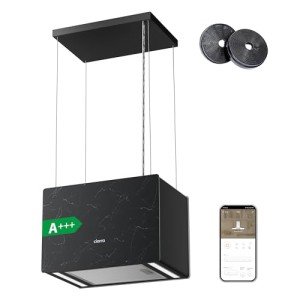How to Aerate an Island Vent Hood
Suspended from the ceiling, an island vent hood helps flow air and keeps your kitchen devoid of smoke and smells. It's also an elegant function that improves your cooking space.
Ventilation types consist of external venting, which pushes air through ductwork to the exterior of your home, and recirculating designs that filter and recycle cooking fumes. island cooker extractor can even be transformed in between one and the other.
Ventilation
Unlike wall-mounted range hoods that vent air vertically through the wall to the outside, island vent hoods use ductwork that goes through the ceiling to exhaust the cooking area to the outdoors. The distinction is that they can likewise be used to recirculate air.
Discover our selection of business and designer customized hoods with powerful ventilation systems. With adjustable specs, find the ideal hood for your kitchen space.
Dacor's ConnectOn auto-responsive technology turns on the hood and ramps up the fan speed in reaction to the cooktop, providing powerful efficiency while utilizing minimal noise. It's just another manner in which you can prepare with confidence. Include a touch of contemporary with this stainless-steel pyramid-style wall-mount canopy hood. This hood with dignity accentuates advanced kitchens that follow a more conventional design style and clears the air of smoke, steam and cooking smells.
extractor fan for island
Unlike wall-mounted range hoods that are installed versus the wall, island vent hoods are suspended from the ceiling over an island or peninsula cooktop or range. They also utilize ductwork to tire air out of the home. This design is perfect for kitchen areas that have a lot of open space, and it assists to add visual interest to your space. This brand-new home functions Blackberry stained cherry cabinets on the specification, and a natural stacked stone on the island and vent hood to complement the Gunstock stain on the cabinets. 10ft ceilings and a skylight aid to keep the kitchen brilliant and large.
Noise
While an island vent hood does a terrific job of filtering smoke, grease and odors out of your kitchen, it can also produce some sound that interrupts the tranquility of your cooking space. Thankfully, there are some strategies you can utilize to minimize this noise and permit you to cook in peace.
One of the primary causes of excess range hood sound is triggered by fan motor problems such as stiff bearings or inadequately oiled fans that produce a loud humming sound. Ductwork can likewise add to this problem specifically if the ducts are too little or if they are clogged with dust.
The finest way to reduce sound is to ensure that your vent hood has the highest airflow rating that you can pay for. The Home Ventilating Institute (HVI) suggests an air flow rate of 100 to 250 cfm for wall-mounted hoods over 30-inch large ranges. This hood ought to also have a multispeed fan to allow lower fan speeds throughout light cooking. One of the simplest ways to decrease the noise is to make sure that the ducting is smooth-walled, as corrugated duct limits airflow. You need to likewise keep the duct runs as short and straight as possible to avoid any kinking.
Installation
Ventilation of island range hoods is a different procedure than wall-mounted systems, considering that they are suspended from the ceiling over an island or peninsula cooktop or stove. They normally require a duct that goes through the ceiling and out through the roof, which can be a complex task for an unexperienced homeowner.
In addition, they must be set up at least 24-inches to 36-inches above the cooking surface. The height might vary, depending upon the size of the hood and the ceiling. If you have existing ducting and electrical circuitry in the kitchen ceiling, this kind of vent hood is fairly easy to set up. If not, it's suggested that you consult a professional.
To begin setup, make sure the hood can fit through the opening you have picked for the vent which it's the right width to accommodate the ductwork and exhaust. If the hood is too broad, it can decrease the effectiveness of the vent and will increase sound levels. Next, cut a small hole in the ceiling and use a wire cutter to examine that there's no plumbing or electrical wiring near the hole. If there is, consider working with an expert for the job or switching to a recirculating system.
If there isn't, you can begin the bigger vent hole by drilling locator holes with a drill and a 1/2-inch masonry bit in each corner of the location. Then utilize a jigsaw to cut the larger vent hole. Finally, include a drywall patch and paint to end up the job. As soon as the hood remains in place, you can run the electrical wiring and connect it to your breaker box. Follow your manufacturer's instructions for complete installation information.

